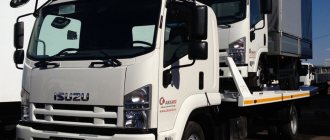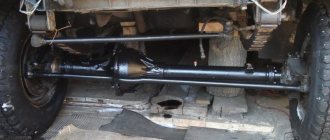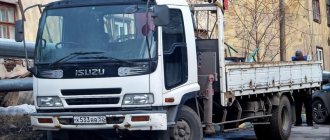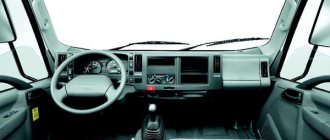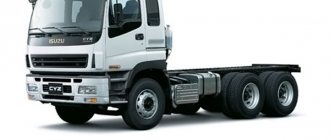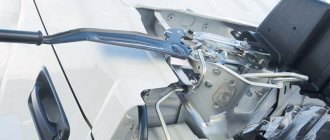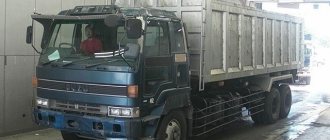Isuzu N series trucks are popular in Russia and throughout the post-Soviet space. This is explained by the technical characteristics of the vehicle, reliability and unpretentiousness.
TFK-MOTORS LLC is a reliable supplier of spare parts for Isuzu
The Isuzu NQR75 is a restyled model of the NQR71 and has an extended chassis by 360 mm and a plus 710 mm in total length. There are also small external differences between the 75 body and the 71, namely
- front bumper shape
- fog lights
- rear view mirrors are placed according to the European type
You can purchase spare parts for Isuzu in our online store
"Russian" Isuzu NQR71 and NQR75
In the summer of 2006 (now Sollers) and Isuzu Motors entered into an agreement to assemble Japanese light-duty vehicles in Russia. In the first years of production, they were assembled in, and then they still went under the designation Isuzu NQR71. A few years later, the production of restyled delivery trucks with the index NQR75P and NQR75R (chassis with a wheelbase extended by 36 cm and a total length of 71 cm) was transferred to the special economic zone “Alabuga”, in the industrial zone of the city of Elabuga, Tatarstan.
The appearance of the modernized NQR75 truck was not very original. It remained a typical Asian city truck - low-mounted cab, “slanted” headlights. However, there are still some obvious external differences between the NQR75 and its predecessor, the NQR71.
First of all, the slightly changed shape of the front bumper, which also features fog lights, is striking. Secondly, the rear-view mirrors are placed according to the European type: on the doors, and not according to the Asian type - in front of the side parts of the cabin, on long brackets.
Cost Volume flow
| Fuel consumption Isuzu Forward 10 tons. Advantages of the car • DRIVER; S TALK Often the equipment in question acts as a base for installing special equipment for a car lift, isometric van, or manipulator. And the high performance of the ISUZU FORWARD chassis and uninterrupted operation in all climatic zones of Russia are a powerful argument that allows the owner to plan any trip. |
- ISUZU GIGA
. Isuzu Giga heavy series trucks are called monsters. These tractors look impressive and can handle the toughest jobs. They began to be produced relatively recently: in 1994. “Gigs” are traditionally classified as the second generation. - ISUZU ELF
. Isuzu Elf is a sixth-generation light-duty and medium-duty truck. The universal frame allows you to adapt the car for many purposes, for example, turning it into a tow truck. Isuzu trucks are very maneuverable and feel great on city streets.
Scope of application of the machine
All Isuzu NQR series trucks are designed as multi-purpose vehicles with a wide range of applications. They are produced in the form of a universal chassis for installing add-ons for various purposes. This can be a standard flatbed cargo platform, a regular or thermal van, a refrigerated unit, a tow truck, a flatbed with a red manipulator installation, a garbage truck body, a compact dump truck, an assembly tower, and so on.
Unlike many other car manufacturers, the Sollers company produced part of the chassis immediately with its own superstructures. And a certain amount of work on the manufacture and installation of various special superstructures was given to third-party, also domestic, companies.
The most common configuration option for a truck chassis of this model is a manufactured goods or insulated van with rear hinged doors. They are made on the basis of welded frame structures from stamped profiles. With external cladding made of galvanized sheets with polymer coating. The van is attached to the truck frame with brackets with bolted connections and secured with plates that prevent lateral, longitudinal and transverse displacements of the body. The van doors in the open position are secured with locking mechanisms, which, like the hinges, are made of stainless steel.
Chassis models and add-ons
There are two chassis modifications - NQR75P and NQR75R. The latter is distinguished by an increased length of 710 mm and a wheelbase of 360 mm.
The platform of the model produces manufactured goods, furniture, and insulated vans coated with clad plywood, galvanized steel, and plastic. Monolithic sandwich panels made of polyurethane foam can be used for thermal insulation.
The chassis is equipped with add-ons:
- tented - with a collapsible frame and a roof made of arches. PVC covering;
- side – with a wall height of galvanized steel of 400 mm;
- tow truck – sliding hydraulic platform, hydraulically driven winch;
- tail lift – hydraulically controlled lifting and lowering of the tailgate;
- loader crane – installed behind the cabin, driven by a power take-off, two retractable sections, five control points;
- installation tower in telescopic or articulated design, lifting height, respectively, 18 and 22 m.
Design Features
From the very beginning of the production of N series cars, Isuzu specialists stated that these cars were created for the harsh conditions of everyday use and were equipped with an impressive margin of safety. This statement can be easily believed, just look at the powerful riveted frame of the Isuzu NQR75R, with side members 216 mm high. In addition, widely spaced leaf springs (the distance between which is 850 mm) and a frame of constant width help the truck to cope with heavy loads, including those exceeding the standard ones, without any problems.
The total weight of the vehicle established by the manufacturer “according to the passport” should not exceed 7.5 tons. The NQR75R's cabin, as well as its frame, has been carefully treated to prevent corrosion. The suspension is made entirely of springs. The rear suspension is additionally reinforced with five-leaf springs. Axle buffer stops were installed on the frames of NQR75R vehicles.
Isuzu NQR75 trucks are distinguished by simple controls and a very small turning radius, which facilitates productive work in distribution - in cramped conditions of a big city, and successful maneuvering at small unloading sites.
The truck's layout is cabover, the cabin is located above the engine; typically Asian - in which the driver sits, literally, “on a wheel”. The passenger, of course, too. The vehicle's electrical system has a constant voltage of 24 V, the negative terminal of the battery is grounded to ground. The four kilowatt starter mechanism is located in the gear motor housing. The alternating current generator unit for 24 V and 60 A is connected to an integral regulator and a current rectifier.
Isuzu Trooper © Volume flow
If during vehicle operation and after successful regeneration the DPD lamp starts to light up frequently and the engine requires burning, then the fuel injectors should be checked. The service will find the breakdown and fix it within a few hours, since Isuzu is made in such a way that for each system, be it control, chassis or electrical, there are certain units responsible for the serviceability of this or that equipment.
| Gross weight – 12,000 kg | Chassis without additional equipment, rub. | Car equipped with sides, rub. | Van for transporting goods, rub. | Special equipment, rub. |
| 3 290 000 | 3 800 000 | 4 567 000 | 4 700 000 | |
| Gross weight – 18,000 kg | Chassis without equipment, rub. | Flatbed vehicle, rub. | Van for transportation of industrial goods, rub. | Special equipment, rub. |
| 3 710 000 | 4 100 000 | 4 570 000 | 4 700 000 |
Engine Isuzu NQR75R
Another difference between the NQR75 and the NQR71, no longer external, but internal, is a different power unit. If earlier, the 71st model was equipped with a 4HG1-T diesel engine with a displacement of 4.5 liters and a power of 120 horsepower, then the NQR75 used a diesel engine of the 4HK1 model - with a displacement of 5.19 liters and a power of 150 horsepower.
This is a four-stroke, four-cylinder, single-row power unit with a mechanical injection system - there are no “Common Rails” here yet. The torque of the motor on the shaft is 404 Hm. The valves and their drive mechanisms are located at the top. By the way, according to the manufacturer’s technical data, it turns out that the standard carrying capacity of the 75th model has become half a ton less. True, it is unknown why.
But, be that as it may, the 4NK1 power unit immediately attracts attention with its solid declared service life: one million kilometers. It really has extremely high reliability, and if it is properly operated and maintained in a timely manner, it can run smoothly for more than 1 million kilometers. It is also very simple in its design, and any driver, even not a super professional, can handle its maintenance or routine minor repairs. The 4HK1 diesel engine has a cast iron block and dry type cylinder liners.
According to the manufacturers, the lack of turbocharging and an increase in engine volume (compared to the predecessor model) was ultimately aimed at reducing the costs associated with operating the truck.
Upon closer acquaintance
The Isuzu NQR 71P does not impress with its modern design or outstanding dynamic qualities. This is an ordinary Asian truck, more reliable and more convenient than domestic counterparts, not very difficult and capricious to maintain, like some Europeans. Overall it is no better or worse than other trucks. And it may well be in demand in Russia, since its high initial price is quite comparable to the promised resource. Moreover, Isuzu can be used not only as a truck, but also as a bus chassis. You don’t have to look far for an example: in Ukraine, where they have long been accustomed to this brand, in addition to trucks, popular Bogdan buses are built on this chassis. We should expect approximately the same development of events in our country, but at the same time we would like the standard equipment of the Russian Isuzu NQR 71P not to be as poor as it is now.
Test vehicle provided
Test results of van model 372433 on Isuzu NQR 71P chassis for fuel efficiency and speed properties
| The tests were carried out on the dynamometer track of the FSUE NITSIAMT test site in accordance with the methodology set out in GOST 22576–90 and GOST 20306–90 | |||||||
| Isuzu NQR 71P van 372433 | GAZ-33104 with awning | DAF LF 45.150 van | JAC HFC1083K onboard | MAZ-437040 with awning | KamAZ-43081 with awning | KamAZ-43081 van "Techpro" | |
| Testing | "GP" No. 5, 2007 | "GP", No. 1, 2005 | "GP", No. 8 2006 | "GP", No. 12, 2005 | "GP", No. 5, 2004 | October 28, 2004 | "GP", No. 8 2004 |
| Vehicle weight, kg | 7900 | 7400 | 7600 | 8830 | 10 350 | 11 000 | 11 500 |
Fuel consumption (at speed km/h), l/100 km:
| 14,7 16,6 19,3 22,4 26,3 28,4 | 12,4 13,1 15,0 17,4 21,7 23,6 | 9,8 11,6 13,8 15,9 18,2 24,7 | 11,3 12,8 14,7 17,1 – – | 17,1 19,9 23,5 27,0 – 27,7 | – 15,8 – 21,6 – – | 13,6 15,7 18,0 20,7 – 26,7 |
| Maximum speed, km/h | 93,8 | 98,0 | – | 102,5 | 82,3 | 104,4 | 97,2 |
| Consumption in datum mode*, l/100 km (at average speed, km/h) | 19,9 (39,5) | – | 19,0 (40,1) | 20,9 (38,1) | 27,8 (37,6) | – | 26,1 (40,1) |
| Average fuel consumption on the Dmitrov–Zaprudnya–Dmitrov section (56 km), l/100 km (at average speed, km/h) | 20,7 (79,4) | – | – | – | – | – | – |
| Run-out distance from a speed of 50 km/h, m | 504 | 683 | 1052 | – | 547 | 1034 | 1150 |
| Acceleration time from standstill to speed 60 km/h, s | 26,6 | 39,0** | 19,4 | 23,7 | – | 26,6 | 25,6 |
Acceleration time from standstill along the way, s:
| 34,7 63,2 | 31,4 68,3 | – – | 32,2 58,5 | – – | 34,4 60,8 | 32,7 60,2 |
*IGD – test cycle for simulating urban traffic.
**Up to 80 km/h. Atmospheric conditions during testing
| Isuzu NQR 71P van 372433 | GAZ-33104 with awning | DAF LF 45.150 van | JAC HFC1083K onboard | MAZ-437040 with awning | KamAZ-43081 with awning | KamAZ-43081 van "Techpro" | |
| Testing | "GP" No. 5, 2007 | "GP", No. 1, 2005 | "GP", No. 8 2006 | "GP", No. 12, 2005 | "GP", No. 5, 2004 | October 28, 2004 | "GP", No. 8 2004 |
| Temperature, °C | 11–13 | 15 | 26–28 | 16 | –3…–6 | 10 | 15–22 |
| Wind speed, m/s | 2–5 | 1–2 | 1–5 | 1–3 | 1–4 | 1–3 | 1–3 |
| Pressure, hPa | 995–992 | 745 | 1002–1006 | 974 | 989–995 | 986 | 995–1001 |
| Relative humidity, % | 79–82 | 74 | 41–45 | 57 | 80–89 | 79 | 61–69 |
Transmission
Isuzu NQR75R cars were produced with only one type of transmission. This is a manual gearbox, five-speed + one reverse gear. The clutch is installed as a single-disc dry type. With an empty truck, you can freely move away immediately from second gear. When you press the accelerator pedal, the car responds with quite noticeable acceleration; after engaging third gear, the engine picks it up quite easily and quickly picks up speed. However, upon reaching a speed of approximately seventy kilometers per hour, the truck becomes much less agile, which, in principle, is absolutely normal for a vehicle of this type.
As a rule, questions about the operation of the five-speed manual transmission do not arise even longer than about the engine. It is reliable and trouble-free and does not require additional maintenance. The lever fits comfortably in the palm of your hand, and all speeds are activated clearly, virtually without any effort, just like in a car. Wheel drive is rear.
The Isuzu NQR75R manual transmission body also houses a mechanism for power take-off for additional equipment - with electric or cable-driven activation, and a hydraulic pump. The cardan shaft is tubular type, with an intermediate support, crosspieces and a sliding fork. Driven continuous rear axle. The main gear has a hypoid type gearing.
NPR75’s place in the company’s lineup and in the domestic car market
In the Isuzu Motors lineup, the NPR75 truck did not become a model developed from scratch: it replaced the Isuzu NQR75, which had stable success in the market in many countries. However, it did not duplicate it: the Isuzu NPR75 is an updated model with a six-speed gearbox, an improved cabin and more solid technical characteristics. Cars of this model have a rather original and memorable appearance, and they do not get lost in the general city traffic flow.
The NPR75 trucks are the most sought after in the Isuzu range due to their highest degree of versatility. The machine is suitable for both city use and long-haul cargo transportation; it will not get lost in traffic due to its memorable appearance and advanced characteristics.
In general, the medium-duty truck segment has shown a steady growth trend in the Russian Federation in recent years. The annual increase in cargo transportation volumes has a corresponding effect on the quantitative growth of the fleet of transport and trading enterprises in the country.
Along with the Isuzu NPR, one of the most striking and popular in the segment under consideration are its closest competitors - the Hyundai HD78 trucks. Both of these models can be called typical representatives of the auto industry of their countries. From year to year they remain in great demand on the Russian market.
Brake and steering systems Isuzu NQR75R
All wheels of the Isuzu NQR75R have classic drum brakes. The brake system is of a dual-circuit type. ABS - anti-lock braking system - is included as standard. The brake system of this truck is of a dual-circuit type. The hydraulic power steering and the car's brake booster are located on the car in one single unit. The steering column is fully adjustable in telescoping and tilting.
According to manufacturers, Isuzu NQR75R brake pads “go” over 200-300 thousand kilometers. Although, of course, a lot also depends on the driving style of each individual driver. The car is equipped with a parking brake of a drum design with a cable connection, and a mountain brake, which simplifies braking using the influence of the diesel engine. The exhaust brake is a vacuum-driven flap that closes the engine exhaust tract.
The attitude towards the car has changed,
as soon as we drove it a few kilometers. The steering turned out to be very light and predictable. During maneuvers, the steering wheel rotates with literally one finger, and at maximum speed it was necessary to correct the direction of the car only with subtle movements of the hands. The acceleration dynamics of Isuzu, especially at the initial stage, are quite satisfactory if you spin the engine up to 2800–3000 rpm. After 60–70 km/h, the car becomes less playful, even if you continue to increase the engine speed to 4000. The engine power is no longer enough, and overtaking in top gear on the Isuzu turns out to be sluggish and strained. And even before overtaking, you begin to think about whether to overtake with a loaded car or not? Moreover, in top gear, long climbs are difficult - the banal lack of power reserve in the engine affects it.
If you don’t squeeze all the juice out of the car, but move along the highway in a calm mode, at an average speed of 70–80 km/h, then you begin to experience some pleasure from driving this truck. And in the city, this car is generally unrivaled - excellent visibility, minimal turning radii and ease of controls.
True, he had one peculiarity - he refused to coast. As soon as you take your foot off the gas pedal, the “Japanese” immediately begins to lose speed (see the “coasting path” column in the test table). This effect is also observed when driving downhill - the car practically does not pick up speed when freely rolling down. And this is not a malfunction of the brake system. We checked. This is a feature of the car itself, and, it seems to us, is largely due to the installed Bridgestone tires with high rolling resistance. The piquancy was also in the fact that Isuzu is standardly equipped with an engine brake, which is supposed to slow down the car downhill, but there is simply no need for this system; the car copes well with its own deceleration without it.
But the Isuzu service brake system with standard ABS works very well, even despite the drum brakes on all wheels. What was especially pleasing was that the car’s braking efficiency increased in strict accordance with the force of pressing the brake pedal. It seems that this is how it should be, but for some reason this dependence is not observed on Chinese copies of Isuzu.
Cabin and driver's workplace
Of course, the driver of a delivery truck (who is also usually a freight forwarder in one person) has to get in and out of the cab many times during a shift. In the Isuzu NQR75R, everything has been done to ensure that people do not have any problems with this. The handrails are located in an exceptionally good location, and the height of the entrance step is also at the most optimal height.
The driver's seat has very few adjustments, however, a comfortable driving position can also be achieved using the height and tilt of the steering column that can be adjusted to different levels. The pedal combination and the placement of the gear shift lever also do not raise any questions.
All instruments on the front panel are not blocked by the steering wheel and are easy to read, have large digitization and clear scales. In general, the interior of the cabin is quite simple and unpretentious, and the finishing materials are cheap. This, however, does not cause surprise: what else can you expect from an outdated truck model that has been produced for many years? The main thing is that the quality of the cabin finishing elements themselves and how they fit together is certainly good.
In general, the NQR75R cabin is designed for three people. If they are small and thin Japanese, then, of course, yes. But in general, there will be enough space for two passengers and our domestic build, unless they are very heavy. There is sufficient free space for both the legs and heads of passengers. And there's even space above the windshield for a very useful storage rack.
If you fold the backrest of the middle passenger seat, you get a convenient and also useful little table, and behind the backrest of passenger seat No. 2 there is a jack and a set of tools. Inside there are also many other various storage compartments and shelves. The roof of the cab of this delivery vehicle is equipped with a ventilation hatch with two-mode adjustment.
Electric windows. The rear-view mirrors do not have electric drive and are not provided for. The truck can be equipped with a variety of options - a car radio, a navigator, communication and control equipment. At the factory, preparations were made for the installation of the specified additional equipment, wiring was laid, power and switching connectors were installed.
Get comfortable
When driving an Isuzu, the tilt and height adjustable steering column helps, but there is little hope for adjusting the driver's seat. The most you can count on is the longitudinal movement of the chair and the adjustment of the backrest angle. The gearshift lever is located between the seats, but somewhat further from the driver than we would like. The gears shift clearly, you get into the right one the first time, but the effort when shifting is too great. The shift pattern of the 5-speed gearbox is reminiscent of front-wheel drive Ladas, only the first gear here is clearly a “spare” gear - during testing we never had a need to engage it. Apparently, it is designed to accelerate a loaded car on incredible climbs or force some kind of dense off-road terrain.
Starting the engine immediately revealed a hole in the sound insulation. According to subjective sensations, at idle speed the engine in the “native” Isuzu is no quieter than in the Chinese counterparts, but unlike them, there is no vibration from the engine in the cabin of the Japanese truck. Looking ahead a little, I will say that noise is the only noticeable drawback of the car; the rest of the identified shortcomings can be easily tolerated.
By the way, when starting the engine after a cold stop, the car has the ability to manually adjust the idle speed. If the engine is unstable after starting, you can increase its speed directly from the cab, achieving stable operation. The main thing is to remember to return the engine speed to nominal before starting to drive.
The clutch reservoir is built into the instrument panel
Other technical characteristics in numbers
- Overall dimensions: length 6.61 m; width – 1.995 m; height – 2.3 m.
- Track size: front – 1.68 m, rear – 1.65 m.
- Tire size – 215/75 R17.5.
- The turning radius is 7.6 meters.
- Curb weight - 2.46 tons.
- The total load capacity of the chassis is 5.04 tons.
- The maximum loaded weight is 7.5 tons.
- Ground clearance – 2З5 mm.
- The volume of the fuel tank is 100 liters.
- Diesel fuel consumption at full load is 17 liters per 100 kilometers.
Isuzu NPR 75 LL 2door. chassis, 150 hp, 6 manual transmission, - increased fuel consumption
content .. 869 870 871 ..Increased fuel consumption
| Check the condition of the air filter replacement element | Blow or replace the air filter element | |
| Leaking power system | Smell of gasoline, fuel leaks | Check the tightness of the connections of the fuel system elements; If a malfunction is detected, replace the corresponding components |
| Spark plugs are faulty: current leakage through cracks in the insulator or carbon deposits on the heat cone, poor contact of the central electrode | Spark plugs are checked on a special stand at a service station. The absence of external damage and sparking between the electrodes on the inverted spark plug does not allow us to draw a conclusion about its functionality | Replace spark plugs |
| Throttle actuator malfunction | Check the travel of the gas pedal, the clearance in the drive (free play of the pedal), make sure that the cable and pedal are not jammed | Replace faulty parts, lubricate the cable with engine oil |
| The idle speed controller or its circuits are faulty | Replace the regulator with a known good one. | Replace the faulty regulator |
| The throttle valve does not close completely | The gap between the throttle valve and the walls of the housing is visible in the light | Replace the throttle assembly |
| Increased pressure in the fuel line due to a faulty pressure regulator | Check the pressure in the fuel system with a pressure gauge (no more than 3.5 bar) | Replace the faulty regulator |
| Leaking injectors | Check the injectors | Replace faulty injectors |
| The coolant temperature sensor or its circuit is faulty | Check the sensor resistance with an ohmmeter at different temperatures | Restore contact in electrical circuits, replace the faulty sensor |
| The oxygen concentration sensor is faulty | You can evaluate the performance of the oxygen concentration sensor and the reliability of its electrical circuit connections using diagnostic equipment at a service station | Restore damaged electrical circuits, replace faulty sensor |
| The ECU or its circuits are faulty | To check, replace the ECU with a known good one. | Replace the faulty ECU, restore damaged electrical circuits |
| Low compression in the engine cylinders (less than 11.0 bar): clearances in the drive are not adjusted, wear or damage to the valves, their guides and seats, stuck or broken piston rings | Check compression | Adjust the clearances in the valve drive. Replace faulty parts |
| The throttle position sensor, absolute pressure and air temperature sensors in the intake manifold or their circuits are faulty | Check the sensors and their circuits | Restore contact in the electrical circuits, replace the faulty sensor(s) |
| Increased resistance to gas movement in the exhaust system | Inspect the exhaust system for dented or damaged pipes, check the condition of the catalytic converter | Replace damaged exhaust system components |
| Malfunctions of the chassis and brake system | Check the chassis and brake system | Adjust the wheel alignment angles, replace faulty chassis parts, and troubleshoot the brake system. |
Reasons for high fuel consumption
There are several common mistakes that inexperienced drivers make that lead to excessive fuel consumption. Remember that excess gasoline or diesel fuel will be consumed when:
The operation of the air conditioner or climate control system. The operation of these devices is related to the operation of the compressor. After all, to rotate the pump pulley, energy is required, which is taken from the rotating crankshaft. And it requires additional fuel. The operation of the heating system. This applies not only to the operation of the “stove”, but also to heated seats, windows and mirrors (in cars where these options are provided). The logic here is similar to the situation described above. Sharp acceleration. If you like to pull away quickly at traffic lights or other places, then be prepared for the fact that your car will consume more fuel than usual. This is due to the fact that any transient process (in this case, setting the machine in motion) is associated with increased energy consumption. And the sharper it is, the more energy is needed. Therefore, try to move off smoothly. This way you will not only save fuel, but also save tires, clutch and power unit components. Engine running at high speeds. Try not to over-gas. This will not only save fuel for your car, but will also have a positive effect on the overall performance of the engine. Using low-quality fuel. Try to refuel at trusted gas stations and fill the tank with the brand of fuel recommended by the car manufacturer. After all, bad fuel burns worse, provides insufficient energy and requires additional energy consumption.
Technical reasons for increased fuel consumption
First, let's look at the technical problems that contribute to increased gas mileage in a car. Let's find out the most common reasons related to the engine and other elements that increase consumption.
Engine wear
Usually occurs due to high mileage of the car or due to improper use. Some points related to engine operation:
coolant temperature is lower than calculated; wear of the cylinder-piston group; wear of the crank mechanism; wear of the gas distribution mechanism and unadjusted valve clearances.
Clutch wear
When the driver needs to keep high revs in order to get off the road and switch to a higher gear, this directly affects fuel consumption. In this case, replacing the clutch will help.
One of the reasons for increased fuel consumption is clutch disc wear. The situation here is quite simple. During the starting process, the engine consumes more fuel than at constant speed. This fact is present even with a working clutch. If the disk or other parts of the system are faulty, then it turns out that fuel is consumed, and the car stands still. The more often the car starts moving, the greater the excess fuel consumption occurs.
In critical cases, a similar situation can occur even when driving in constant mode. That is, when the clutch disc does not ensure synchronous rotation of the engine and gearbox. This situation, although rare, can happen in the most “neglected” cases.
Diagnosing clutch wear is quite simple. To do this, you need to put the car on the handbrake, engage fifth or fourth gear (depending on the gearbox, that is, the highest) and try to get going. If you do not turn off the engine with gas, this means that the clutch needs to be repaired or completely replaced.
Ignition set incorrectly
Incorrectly set ignition also causes increased fuel consumption. In particular, if the engine “troubles”, then gasoline from the idle cylinder is released directly into the exhaust system. This leads not only to excessive fuel consumption, but also to increased wear of the catalyst.
If the ignition is simply set incorrectly, then a situation arises when the fuel does not burn completely. That is, a spark occurs before the fuel mixture appears in the cylinder in full, or after that. In any case, this leads to its incomplete combustion. This automatically means that fuel is wasted.
Therefore, always monitor the condition of the ignition system. The amount of fuel consumed directly depends on this. In addition, an incorrectly configured ignition system can cause problems when starting the engine.
Tire wear
If the tires are worn out enough or the pressure in them is less than normal, this will also lead to the car starting to “eat” more than it should. In such a situation, it is necessary to replace the tires and regularly check the tire pressure. Low-profile tires with a wide tread create increased resistance and, accordingly, increased fuel consumption.
Malfunctions of the brake system They are different, let’s consider those that lead to incomplete release of the calipers, when the so-called “wedging” occurs. If the caliper is not fully unclenched, then over time not only the brake pads, but also the discs become unusable. Due to excessive friction and resistance, fuel consumption naturally increases.
Broken spark plugs
Due to unsuitable spark plugs, the car does not operate correctly, which results in additional load on the engine. This leads not only to high fuel consumption, but also to a general deterioration in performance. To avoid this, you need to check the spark plugs. Such a check includes examining the color of carbon deposits, measuring the electrode gap, and checking the resistor for breakdown. It is also worth paying attention to the junction of the white insulator to the threaded part of the spark plug - a red coating is unacceptable.
Clogged injectors or carburetor
Clogged injectors are one of the most common causes of excessive fuel consumption. They become clogged due to natural causes. These include the use of low-quality gasoline, untimely replacement of the fuel filter, dirt getting into the engine compartment, and so on.
When the injectors are clogged, the shape of the fuel spray pattern in the combustion chamber is disrupted. Because of this, the formation of the fuel mixture is disrupted. That is, this process uses more gasoline than is necessary under normal conditions.
In some cases, due to clogged injectors, the engine may begin to “trouble.” This is expressed in a decrease in the dynamic characteristics of the car. It is also possible for the engine to operate for a long time at high speeds, even in idle mode. This naturally leads to increased fuel consumption.
Similar reasoning is valid for cars with a carburetor engine. When the carburetor becomes clogged, the same situation arises with excessive consumption of gasoline and a drop in dynamic characteristics.
Therefore, always monitor the condition of the fuel system, in particular, the injectors on an injection engine and the carburetor on a carburetor. Their clogging is a direct cause of excessive fuel consumption.
Low-octane fuel also has a great effect on consumption (low price and poor quality come with quantity).
Damage to the lambda probe or mass air flow sensor
Failure of the oxygen sensor (lambda probe) can also lead to significant excess fuel consumption. Its task is to control the amount of oxygen that goes into the fuel mixture. Therefore, if this sensor is faulty, the mixture will be created incorrectly, and this will lead to excessive fuel consumption.
The lambda probe is quite fragile. There are a number of reasons why it can fail. Among them:
depressurization of its body and penetration of exhaust gases into it; overheating of the sensor (this may be caused by incorrect operation of the ignition system); natural aging and wear; problems with the car's electrical network; mechanical damage to the sensor. Similar reasoning applies to the mass air flow sensor (MAF). It is designed to regulate the level of air supply to the engine cylinders. Sensor malfunctions are easy to identify. As a rule, in this case the engine begins to operate unstably, especially at idle (very high or low “jumping” speeds), loss of dynamic characteristics (the car accelerates poorly). The mass air flow sensor cannot be repaired. It can only be replaced, although cleaning it may temporarily correct the situation.
Clogged air filter
The recommended replacement frequency is every 15,000 km. Timely replacement of the air filter is required, because if it is clogged and you ignore it, then be prepared for the car to have a good appetite.
Consumption is also affected by the use of air filter elements with heavy fabric pre-cleaners, since, as in the case of a clogged filter, air resistance increases. Lightweight filter elements are recommended to minimize air flow resistance.
Specifications
Technical characteristics of Isuzu NPR 75 LL / Isuzu in the body 2 doors. chassis with a 150 hp engine, 6-speed manual transmission, produced since
Basic data
- Start of production:
unknown - End of production:
in production
- Body:
2 doors chassis
Engine
- Fuel grade: diesel fuel
- Engine capacity, cubic meters see: 5193
- Power, hp: 150
Transmission
- Transmission: Manual
- Number of steps: 6
Suspension
- Front: leaf spring
- Rear: spring
Brakes
- Front: drum
- Rear: drum
Dimensions
- Length, mm: 7325
- Width, mm: 2115
- Height, mm: 2265
- Wheelbase, mm: 4175
- Front wheel track, mm: 1680
- Rear wheel track, mm: 1650
Other
- Number of seats: 3
- Tire size: 215/75R17.5
- Curb weight, kg: 2725
- Permissible weight, kg: 7500
- Fuel tank volume, l: 100
content .. 869 870 871 ..
Reviews of Isuzu NQR75R trucks
The reputation of this model in the Russian Federation is almost impeccable. We can rightfully say that the light-duty truck model Isuzu NQR75 R has taken root well on domestic roads. On specialized forums you can find many positive reviews about the experience of using this car.
Most owners and drivers talk about the following advantages of the Isuzu NQR75 R: simplicity of design, ease of maintenance and repair; decent driving performance, maneuverability in modern urban conditions; quite powerful, high-resource diesel engine; warm and quite comfortable cabin; decent sound insulation for trucks of this class.
Almost everyone talks about the good sound insulation of the cabin. Despite the fact that there is a hatch under the middle passenger seat for access to the diesel engine, its growl in the cabin is barely audible. And the vibration of the diesel engine is also practically not transmitted to the machine controls.
The good visibility of the Isuzu NQR75 R deserves good words. The mirror brackets, as already noted, are fixed to the doors; They are also widely spaced and always guarantee excellent visibility to the rear, even if a wide van is installed behind. And the falling lines of the side windows help you easily control the situation on both sides.
Steering with power steering is light and predictable. The suspension, despite the fact that it is completely leaf spring, provides sufficient smoothness even when the truck is empty. The service brake system with standard ABS also works quite effectively.
The cabin reclines in such a way that it really facilitates access to servicing the main units and components of the car. Consumables and spare parts for this model are, for the most part, affordable and not uncommon. We have more than a hundred dealerships in the Russian Federation, where you can make detailed diagnostics and carry out high-quality repairs on a truck of this model.
Like any other vehicle, the Isuzu NQR75 R truck is also not without its shortcomings. The list of main complaints from owners and drivers includes a small amount of additional equipment. Some complain about the low quality of the “original” tires with which the truck is sold, and the weak battery in the basic configuration, as well as its open installation on the vehicle. But in general, these comments cannot be called serious shortcomings and decisive factors when choosing trucks.
Isuzu NQR75 R confidently surpasses Chinese competitors in price, and European ones in simplicity of design and maintenance. There are no expensive or tricky electronics in it. This truck is no more difficult to drive than a subcompact car; It’s maneuverable enough to work in a cramped city, it’s economical, and on top of that, it’s not very difficult to repair. Its reliability is at its best. Cars that have successfully driven a million kilometers or more are strong evidence of this.
N series transport
There are 10 models in the series: all of them are light, compact and durable. Curb weight – no more than 8,000 kg with 5,000 kg load capacity .
The category accounts for more than half of the company's exports to other countries. The demand is explained by the relative cheapness, simplicity of the device, high durability and reliability parameters, which fully confirms the popularity of the machine in the secondary market.
Reviews from ISUZU N car owners on the Internet are mostly positive. Among the disadvantages are the low power of the battery and its open installation.
In order to further develop the N series cargo line, the company has developed and launched a new generation of 700P machines. The five-ton ISUZU NLR85A fully retained all the advantages of the series, receiving:
- a new enlarged cabin with all passive safety elements, heated mirrors, expanded adjustments for the steering column and driver's seat;
- anti-lock braking system (ABS) and anti-slip system (ASR) plus optional brake assist device (EBD);
- electronic injection control on the power unit;
- accelerated engine warm-up unit.
Cost of a used Isuzu NQR75 car
On electronic bulletin boards you can find many offers for the sale of used Isuzu NQR75 trucks from 2006-2014. They ask for from 500 thousand to 1 million 300 thousand rubles: depending on the year of manufacture, mileage, technical condition and equipment of each specific car.
Isuzu NQR75 R trucks have taken root on domestic urban and intraregional roads. Owners of small companies are satisfied with their capabilities, efficiency and profitability, and low operating costs. Drivers consider the comfort of working in this car worthy. Now this model has been replaced by more modern Isuzu light-duty trucks, but the reliable and unpretentious NQR75 R will be traveling around the cities for a long time, performing everyday delivery work.
Isuzu NQR Series Concept
Isuzu trucks of the NQR model range are made by the company's engineers as universal trucks that are capable of solving many problems in a variety of areas. Trucks are produced in the form of a universal chassis, on which it is possible to make various types of superstructures.
- Refrigerators
- Tanks
- Crane arm
- Tow truck
- Garbage truck
- Assembly tower
- Dump truck
- etc
The most popular option is the manufactured goods or isometric van. Its rear doors have a swing system. This allows you to transport various goods in this van. The outside of the van is covered with galvanized sheets. Galvanization is coated with a polymer coating, which protects it from external irritants, dirt, moisture and other things.
You can choose the necessary spare part for any model of Isuzu truck in our online store

